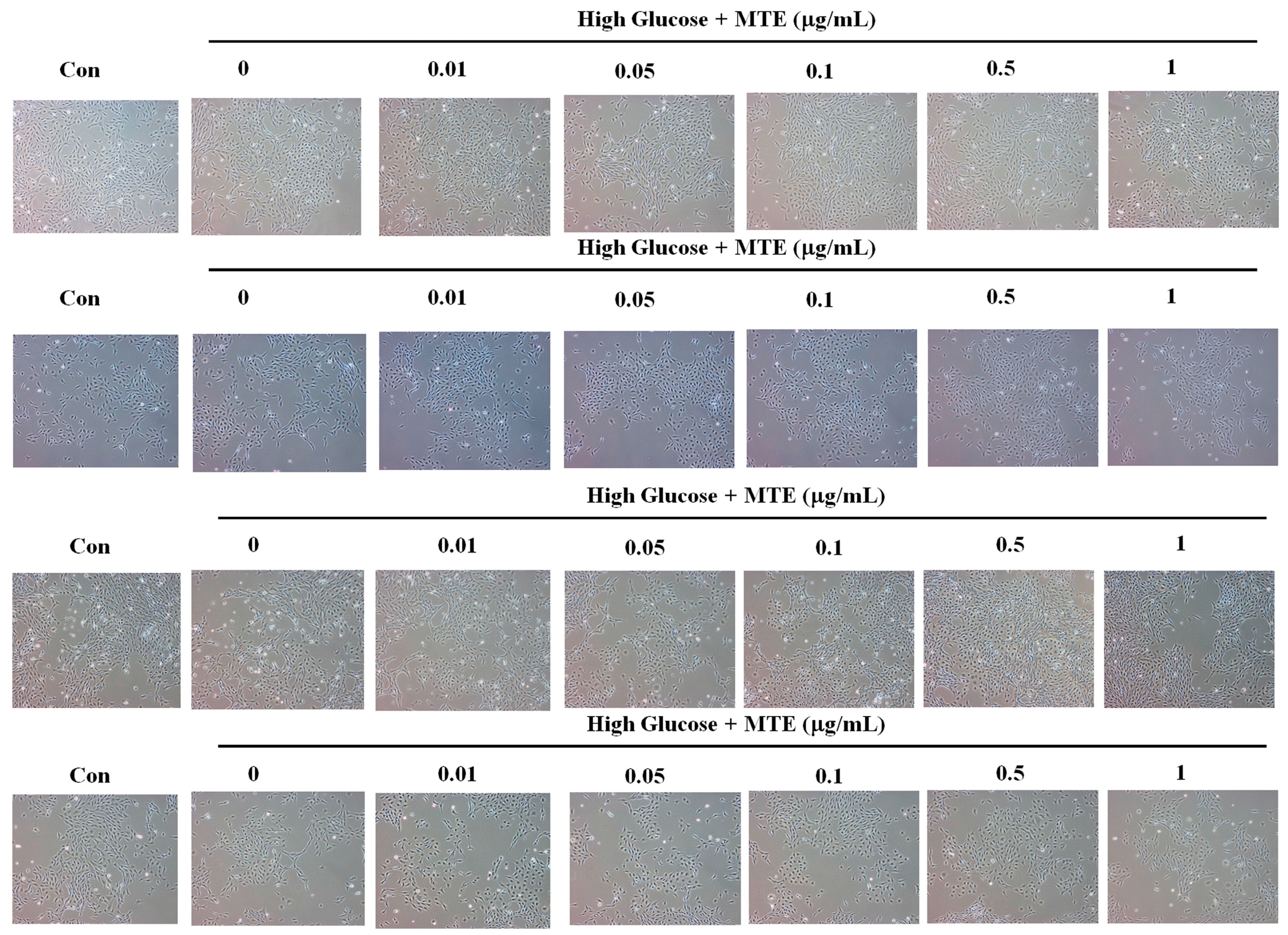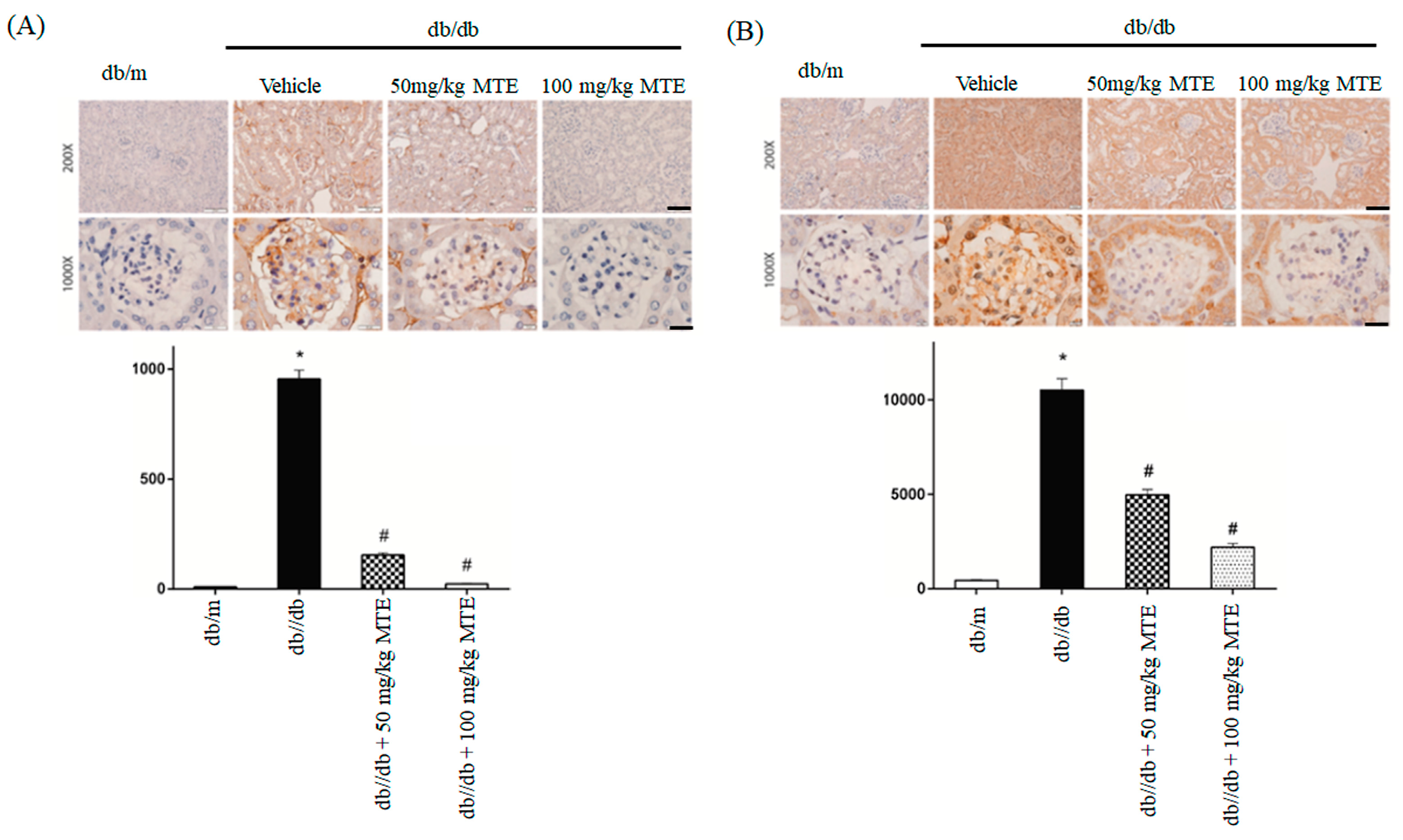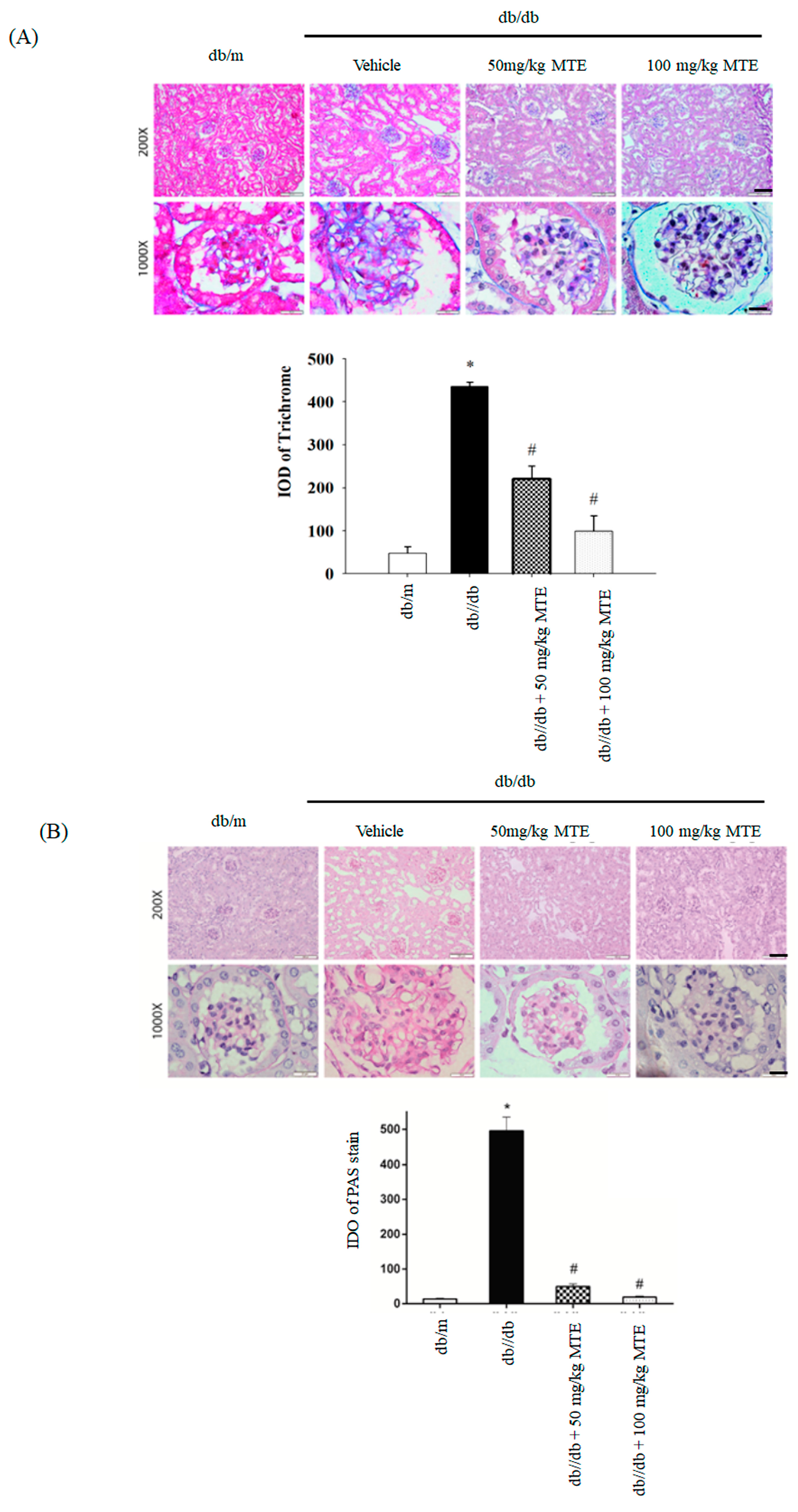Therapeutic Potential of Extracts from Macaranga tanarius (MTE) in Diabetic Nephropathy
Abstract
:1. Introduction
2. Results
2.1. Cytotoxicity Effect of MTE on Mouse Renal Mesangial Cells
2.2. Effects of MTE on Renal Fibrosis In Vivo
3. Discussion
4. Materials and Methods
4.1. Sample Preparation
4.2. Cell Culture
4.3. Quantitative Reverse-Transcription Polymerase Chain Reaction (RT-PCR)
4.4. Western Blot Analysis
4.5. Animal Model
4.6. Histological Staining and Immunohistochemical Analysis
4.7. Statistical Analysis
5. Conclusions
Author Contributions
Funding
Institutional Review Board Statement
Informed Consent Statement
Data Availability Statement
Acknowledgments
Conflicts of Interest
References
- Ogurtsova, K.; Guariguata, L.; Barengo, N.C.; Ruiz, P.L.; Sacre, J.W.; Karuranga, S.; Sun, H.; Boyko, E.J.; Magliano, D.J. IDF diabetes Atlas: Global estimates of undiagnosed diabetes in adults for 2021. Diabetes Res. Clin. Pract. 2022, 183, 109118. [Google Scholar] [CrossRef] [PubMed]
- Whiting, D.R.; Guariguata, L.; Weil, C.; Shaw, J. IDF diabetes atlas: Global estimates of the prevalence of diabetes for 2011 and 2030. Diabetes Res. Clin. Pract. 2011, 94, 311–321. [Google Scholar] [CrossRef]
- Bhattacharjee, N.; Barma, S.; Konwar, N.; Dewanjee, S.; Manna, P. Mechanistic insight of diabetic nephropathy and its pharmacotherapeutic targets: An update. Eur. J. Pharmacol. 2016, 791, 8–24. [Google Scholar] [CrossRef] [PubMed]
- Ahmed, Q.U.; Ali, A.H.M.; Mukhtar, S.; Alsharif, M.A.; Parveen, H.; Sabere, A.S.M.; Nawi, M.S.M.; Khatib, A.; Siddiqui, M.J.; Umar, A.; et al. Medicinal Potential of Isoflavonoids: Polyphenols That May Cure Diabetes. Molecules 2020, 25, 5491. [Google Scholar] [CrossRef]
- Vargas, F.; Romecin, P.; Garcia-Guillen, A.I.; Wangesteen, R.; Vargas-Tendero, P.; Paredes, M.D.; Atucha, N.M.; Garcia-Estan, J. Flavonoids in Kidney Health and Disease. Front. Physiol. 2018, 9, 394. [Google Scholar] [CrossRef]
- Al Hroob, A.M.; Abukhalil, M.H.; Alghonmeen, R.D.; Mahmoud, A.M. Ginger alleviates hyperglycemia-induced oxidative stress, inflammation and apoptosis and protects rats against diabetic nephropathy. Biomed. Pharmacother. 2018, 106, 381–389. [Google Scholar] [CrossRef]
- Suresh Babu, P.; Srinivasan, K. Amelioration of renal lesions associated with diabetes by dietary curcumin in streptozotocin diabetic rats. Mol. Cell Biochem. 1998, 181, 87–96. [Google Scholar] [CrossRef]
- Ezzat, S.M.; Abdallah, H.M.I.; Yassen, N.N.; Radwan, R.A.; Mostafa, E.S.; Salama, M.M.; Salem, M.A. Phenolics from Physalis peruviana fruits ameliorate streptozotocin-induced diabetes and diabetic nephropathy in rats via induction of autophagy and apoptosis regression. Biomed. Pharmacother. 2021, 142, 11948. [Google Scholar] [CrossRef] [PubMed]
- Chtourou, Y.; Morjen, M.; Ammar, R.; Mhiri, R.; Jemaa, M.; ELBini-Dhouib, I.; Fetoui, H.; Srairi-Abid, N.; Marrakchi, N.; Jebali, J. Investigation of the Renal Protective Effect of Combined Dietary Polyphenols in Streptozotocin-Induced Diabetic Aged Rats. Nutrients 2022, 14, 2867. [Google Scholar] [CrossRef] [PubMed]
- Wang, F.; Fan, J.; Pei, T.; He, Z.; Zhang, J.; Ju, L.; Han, Z.; Wang, M.; Xiao, W. Effects of Shenkang Pills on Early-Stage Diabetic Nephropathy in db/db Mice via Inhibiting AURKB/RacGAP1/RhoA Signaling Pathway. Front. Pharmacol. 2022, 13, 781806. [Google Scholar] [CrossRef] [PubMed]
- Xu, W.; Peng, R.; Chen, S.; Wu, C.; Wang, X.; Yu, T.; Jian, J.; Zhang, N.; Zuo, S.; Chen, M.; et al. Ranunculus ternatus Thunb extract attenuates renal fibrosis of diabetic nephropathy via inhibiting SMYD2. Pharm. Biol. 2022, 60, 300–307. [Google Scholar] [CrossRef]
- Kawakami, S.; Harinantenaina, L.; Matsunami, K.; Otsuka, H.; Shinzato, T.; Takeda, Y. Macaflavanones A-G, prenylated flavanones from the leaves of Macaranga tanarius. J. Nat. Prod. 2008, 71, 1872–1876. [Google Scholar] [CrossRef] [PubMed]
- Matsunami, K.; Otsuka, H.; Kondo, K.; Shinzato, T.; Kawahata, M.; Yamaguchi, K.; Takeda, Y. Absolute configuration of (+)-pinoresinol 4-O-[6″-O-galloyl]-beta-D-glucopyranoside, macarangiosides E, and F isolated from the leaves of Macaranga tanarius. Phytochemistry 2009, 70, 1277–1285. [Google Scholar] [CrossRef]
- Chien, Y.H.; Yu, Y.H.; Ye, S.R.; Chen, Y.W. Antibacterial and Antioxidant Activity of the Fruit of Macaranga tanarius, the Plant Origin of Taiwanese Green Propolis. Antioxidants 2022, 11, 1242. [Google Scholar] [CrossRef]
- Nam, S.H.; Yamano, A.; Kim, J.A.; Lim, J.; Baek, S.H.; Kim, J.E.; Kwon, T.G.; Saito, Y.; Teruya, T.; Choi, S.Y.; et al. Prenylflavonoids isolated from Macaranga tanarius stimulate odontoblast differentiation of human dental pulp stem cells and tooth root formation via the mitogen-activated protein kinase and protein kinase B pathways. Int. Endod. J. 2021, 54, 1142–1154. [Google Scholar] [CrossRef]
- Natsume, N.; Yonezawa, T.; Saito, Y.; Woo, J.T.; Teruya, T. Prenylflavonoids from fruit of Macaranga tanarius promote glucose uptake via AMPK activation in L6 myotubes. J. Nat. Med. 2021, 75, 813–823. [Google Scholar] [CrossRef]
- Lee, J.H.; Kim, Y.G.; Khadke, S.K.; Yamano, A.; Woo, J.T.; Lee, J. Antimicrobial and antibiofilm activities of prenylated flavanones from Macaranga tanarius. Phytomedicine 2019, 63, 153033. [Google Scholar] [CrossRef]
- Yoshimura, K.; Hosoya, T.; Fujinami, M.; Ohta, T.; Kumazawa, S. Nymphaeol-C, a prenylflavonoid from Macaranga tanarius, suppresses the expression of fibroblast growth factor 18. Phytomedicine 2017, 36, 238–242. [Google Scholar] [CrossRef] [PubMed]
- Nakashima, K.; Miyashita, H.; Yoshimitsu, H.; Fujiwara, Y.; Nagai, R.; Ikeda, T. Two new prenylflavonoids from Epimedii Herba and their inhibitory effects on advanced glycation end-products. J. Nat. Med. 2016, 70, 290–295. [Google Scholar] [CrossRef] [PubMed]
- Zhao, Y.D.; Zhang, X.; Yang, W.Y.; Zhang, R.Q.; Mu, L.T.; Han, L.; Lv, C.N.; Lu, J.C. New anti-pulmonary fibrosis prenylflavonoid glycosides from Epimedium koreanum. Chin. J. Nat. Med. 2022, 20, 221–228. [Google Scholar] [CrossRef] [PubMed]
- Lu, X.; Liu, M.; Dong, H.; Miao, J.; Stagos, D.; Liu, M. Dietary prenylated flavonoid xanthohumol alleviates oxidative damage and accelerates diabetic wound healing via Nrf2 activation. Food. Chem. Toxicol. 2022, 160, 112813. [Google Scholar] [CrossRef] [PubMed]
- George, S.; Ajikumaran Nair, S.; Johnson, A.J.; Venkataraman, R.; Baby, S. O-prenylated flavonoid, an antidiabetes constituent in Melicope lunu-ankenda. J. Ethnopharmacol. 2015, 168, 158–163. [Google Scholar] [CrossRef]
- Saeedi, P.; Petersohn, I.; Salpea, P.; Malanda, B.; Karuranga, S.; Unwin, N.; Colagiuri, S.; Guariguata, L.; Motala, A.A.; Ogurtsova, K.; et al. Global and regional diabetes prevalence estimates for 2019 and projections for 2030 and 2045: Results from the International Diabetes Federation Diabetes Atlas, 9th edition. Diabetes Res. Clin. Pract. 2019, 157, 107843. [Google Scholar] [CrossRef] [PubMed]
- Sun, H.; Saeedi, P.; Karuranga, S.; Pinkepank, M.; Ogurtsova, K.; Duncan, B.B.; Stein, C.; Basit, A.; Chan, J.C.N.; Mbanya, J.C.; et al. IDF Diabetes Atlas: Global, regional and country-level diabetes prevalence estimates for 2021 and projections for 2045. Diabetes Res. Clin. Pract. 2022, 183, 109119. [Google Scholar] [CrossRef]
- Humphreys, B.D. Mechanisms of Renal Fibrosis. Annu. Rev. Physiol. 2018, 80, 309–326. [Google Scholar] [CrossRef]
- Lee, E.Y.; Kim, G.T.; Hyun, M.; Kim, S.; Seok, S.; Choi, R.; Lee, M.Y.; Chung, C.H. Peroxisome proliferator-activated receptor-delta activation ameliorates albuminuria by preventing nephrin loss and restoring podocyte integrity in type 2 diabetes. Nephrol. Dial. Transplant. 2012, 27, 4069–4079. [Google Scholar] [CrossRef]
- Kang, M.K.; Kim, S.I.; Oh, S.Y.; Na, W.; Kang, Y.H. Tangeretin Ameliorates Glucose-Induced Podocyte Injury through Blocking Epithelial to Mesenchymal Transition Caused by Oxidative Stress and Hypoxia. Int. J. Mol. Sci. 2020, 21, 8577. [Google Scholar] [CrossRef] [PubMed]
- Hidayat, R.; Wulandari, P. Effects of Andrographis paniculata (Burm. F.) Extract on Diabetic Nephropathy in Rats. Rep. Biochem. Mol. Biol. 2021, 10, 445–454. [Google Scholar] [CrossRef]
- Li, X.; Gao, Z.; Gao, H.; Li, B.; Peng, T.; Jiang, B.; Yang, X.; Hu, Z. Nephrin loss is reduced by grape seed proanthocyanidins in the experimental diabetic nephropathy rat model. Mol. Med. Rep. 2017, 16, 9393–9400. [Google Scholar] [CrossRef]
- Sen, Z.; Weida, W.; Jie, M.; Li, S.; Dongming, Z.; Xiaoguang, C. Coumarin glycosides from Hydrangea paniculata slow down the progression of diabetic nephropathy by targeting Nrf2 anti-oxidation and smad2/3-mediated profibrosis. Phytomedicine 2019, 57, 385–395. [Google Scholar] [CrossRef]
- Widyarini, T.; Indarto, D.; Soetrisno, S.; Purwanto, B. Modulation effects of Etlingera elatior ethanol extract as anti-inflammatory on chronic kidney disease in mice with hypertension and diabetes. J. Popul. Ther. Clin. Pharmacol. 2022, 29, e140–e149. [Google Scholar] [PubMed]
- Choi, D.; Kim, C.L.; Kim, J.E.; Mo, J.S.; Jeong, H.S. Hesperetin inhibit EMT in TGF-beta treated podocyte by regulation of mTOR pathway. Biochem. Biophys. Res. Commun. 2020, 528, 154–159. [Google Scholar] [CrossRef] [PubMed]
- Tang, R.; Xiao, X.; Lu, Y.; Li, H.; Zhou, Q.; Kwadwo Nuro-Gyina, P.; Li, X. Interleukin-22 attenuates renal tubular cells inflammation and fibrosis induced by TGF-beta1 through Notch1 signaling pathway. Ren. Fail. 2020, 42, 381–390. [Google Scholar] [CrossRef] [PubMed]
- Yang, Y.Q.; Tan, H.B.; Zhang, X.Y.; Zhang, Y.Z.; Lin, Q.Y.; Huang, M.Y.; Lin, Z.Y.; Mo, J.Z.; Zhang, Y.; Lan, T.; et al. The Chinese medicine Fufang Zhenzhu Tiaozhi capsule protects against renal injury and inflammation in mice with diabetic kidney disease. J. Ethnopharmacol. 2022, 292, 115165. [Google Scholar] [CrossRef] [PubMed]
- Wang, M.; Liu, X.; Wang, Z.; Xu, Q. The extract of Polygala fallax Hemsl. slows the progression of diabetic nephropathy by targeting TLR4 anti-inflammation and MMP-2/9-mediated anti-fibrosis in vitro. Phytomedicine 2022, 104, 154251. [Google Scholar] [CrossRef]
- Yoon, J.J.; Park, J.H.; Lee, Y.J.; Kim, H.Y.; Han, B.H.; Jin, H.G.; Kang, D.G.; Lee, H.S. Protective Effects of Ethanolic Extract from Rhizome of Polygoni avicularis against Renal Fibrosis and Inflammation in a Diabetic Nephropathy Model. Int. J. Mol. Sci. 2021, 22, 7230. [Google Scholar] [CrossRef]
- Hsu, Y.C.; Ho, C.; Shih, Y.H.; Ni, W.C.; Li, Y.C.; Chang, H.C.; Lin, C.L. Knockout of KLF10 Ameliorated Diabetic Renal Fibrosis via Downregulation of DKK-1. Molecules 2022, 27, 2644. [Google Scholar] [CrossRef]
- Kumarappan, C.T.; Mandal, S.C. Polyphenolic extract of Ichnocarpus frutescens attenuates diabetic complications in streptozotocin-treated diabetic rats. Ren. Fail. 2008, 30, 307–322. [Google Scholar] [CrossRef] [PubMed]





| db/m | db/db | |||
|---|---|---|---|---|
| (n = 6) | 0 MTE (n = 6) | 50 mg/kg MTE (n = 6) | 100 mg/kg MTE (n = 6) | |
| HbA1C | 4.12 ± 0.16 | 10.38 ± 0.79 * | 9 ± 3.64 * | 9.12 ± 0.89 * |
| Kidney weight | 0.30 ± 0.03 | 0.42 ± 0.03 * | 0.36 ± 0.15 *,# | 0.38 ± 0.03 *,# |
| Body weight | 32.56 ± 1.70 | 49.34 ± 4.66 * | 50.65 ± 7.02 * | 48.44 ± 4.42 * |
| Kidney weight/body weight | 0.93 ± 0.10 | 0.86 ± 0.09 | 0.72 ± 0.30 | 0.80 ± 0.11 |
| Albumin loss | 0.0097 ± 0.0033 | 0.3685 ± 0.2393 * | 0.1436 ± 0.2514 *,# | 0.1981 ± 0.1227 *,# |
Disclaimer/Publisher’s Note: The statements, opinions and data contained in all publications are solely those of the individual author(s) and contributor(s) and not of MDPI and/or the editor(s). MDPI and/or the editor(s) disclaim responsibility for any injury to people or property resulting from any ideas, methods, instructions or products referred to in the content. |
© 2023 by the authors. Licensee MDPI, Basel, Switzerland. This article is an open access article distributed under the terms and conditions of the Creative Commons Attribution (CC BY) license (https://creativecommons.org/licenses/by/4.0/).
Share and Cite
Hsu, Y.-C.; Chang, C.-C.; Hsieh, C.-C.; Shih, Y.-H.; Chang, H.-C.; Lin, C.-L. Therapeutic Potential of Extracts from Macaranga tanarius (MTE) in Diabetic Nephropathy. Plants 2023, 12, 656. https://doi.org/10.3390/plants12030656
Hsu Y-C, Chang C-C, Hsieh C-C, Shih Y-H, Chang H-C, Lin C-L. Therapeutic Potential of Extracts from Macaranga tanarius (MTE) in Diabetic Nephropathy. Plants. 2023; 12(3):656. https://doi.org/10.3390/plants12030656
Chicago/Turabian StyleHsu, Yung-Chien, Cheng-Chih Chang, Ching-Chuan Hsieh, Ya-Hsueh Shih, Hsiu-Ching Chang, and Chun-Liang Lin. 2023. "Therapeutic Potential of Extracts from Macaranga tanarius (MTE) in Diabetic Nephropathy" Plants 12, no. 3: 656. https://doi.org/10.3390/plants12030656
APA StyleHsu, Y.-C., Chang, C.-C., Hsieh, C.-C., Shih, Y.-H., Chang, H.-C., & Lin, C.-L. (2023). Therapeutic Potential of Extracts from Macaranga tanarius (MTE) in Diabetic Nephropathy. Plants, 12(3), 656. https://doi.org/10.3390/plants12030656






